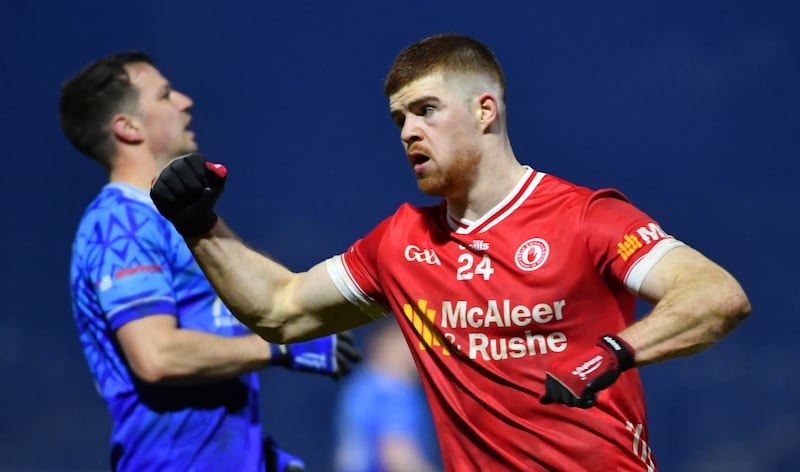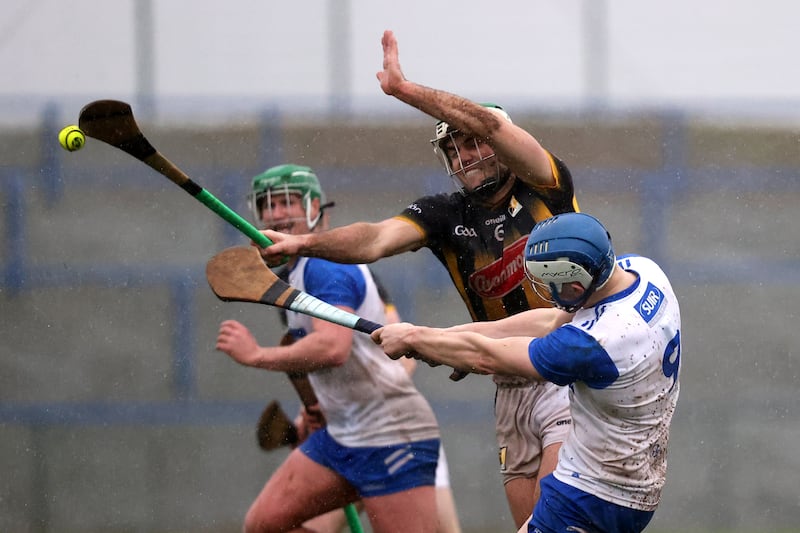Jim McGuinness showing big ambition – and seeing no shame in playing a league final
Every manager has their own different wants and needs from the Allianz Football League. Jim McGuinness has made no secret of the fact he wanted Donegal to win promotion back to Division One, that feat duly achieved with a game in hand on Saturday evening, the comfortable six-point victory sending Kildare in the opposite direction.
Afterwards McGuinness listed off the various reasons why this was important for Donegal, and naturally his own ambitions too. Notably calling it “the first step for this group in many respects” and “where we want to be”. McGuinness also considered it a “very large box ticked”.
He also recalled with some fondness when Donegal played their first Division One match in Croke Park, watching that as a youngster and naturally prompting his own ambitions in other ways too.
McGuinness was then asked about Donegal’s pending schedule, given they’ll host Meath in Ballybofey on Saturday evening, a game of no importance to either team (Meath are safe from relegation), before turning their attention to the Division Two final against Armagh a week later, on Easter Sunday, in Croke Park.
Inside Gaelic Games: The weekly GAA newsletter from The Irish Times
Wild scorelines mean no lead in hurling is safe any more
Five things we learned from the GAA weekend: A ludicrous rule, GAA+ verdict and the joy of Munster
Leitrim’s spirited defeat to Mayo treated with glee compared to glory days of the 1990s
Three weeks after that it’s the big show; the Ulster SFC quarter-final against Derry at Celtic Park on Saturday April 20th. Not every manager would want or need to play a Division Two final so close to that, only McGuinness made no secret of his ambition on that note too.
“A wee bit of breathing space before the championship would be brilliant, but I think it’s tough when you’re reading things and seeing things, people talking about do I want to, or do I not want to, be in a league final.
“I don’t think that’s where we need to be. I don’t think it’s fair on the sponsors. If I’m a sponsor, and listening to people deciding ‘maybe or maybe not I’m interested in playing that game’, I don’t think that serves them well. People need to be motivated to be there, and they only way you can be motivated is to know you have an opportunity to play the game, and still have an opportunity to prepare your team for the championship.
“It’s the manager’s fault, that that clash has been put upon them, but they have to make the decision then. That’s what high level sport is all about.” Ian O’Riordan

The trapdoor finally catches up with Monaghan
A definite changing of the guard in Division One means that we will be deprived of the one of the most popular league shows in recent times: what Monaghan might do on the final weekend. The county’s grimly defiant display in Omagh nearly came up with the credit for another shot at last-day redemption – what would have been a sixth in 10 years – but instead, Vinny Corey’s team have now dropped to Division Two for the first time in a decade.
It feels like a significant moment for the county that has worked miracles to be so prominent in senior football with one of the smallest populations – 65,288 – in the country. Three of last year’s All-Ireland semi-finalists will between them, contest this season’s league title – Derry, Dublin and Kerry. The fourth is Monaghan.
During those 10 years at the top, the county has won an Ulster title and been in two All-Ireland semi-finals as well as provincial finalists in the time of Covid.
Over these 10 years, Monaghan’s championship nemesis has frequently been Tyrone. When they won the 2015 Ulster title, it was the neighbours that defeated them in the All-Ireland quarter-final – as they had done in 2013.
Even in 2021, when the championship had reverted to knockout, the provincial final was contested by the counties, which led to a one-point defeat by Tyrone, then on their way to an All-Ireland.
Inevitable, so – in a roundabout way – that such familiar rivals administered Saturday’s coup de grace. Seán Moran

The long and the short of it
The long ball never went out of the game, but perhaps it might be about to pop its head up a bit more often this summer than it has done in recent championships. There were several examples over the weekend of teams utilising the direct approach.
The exquisite quarterback-esque pass from Niall Morgan downfield to Darragh Canavan garnered most attention, but it certainly was not the only long ball that resulted in scores. Dublin’s return to using Con O’Callaghan on the edge of the square continued to reap rewards against Galway in Salthill on Saturday, while Roscommon were on edge on Sunday because of David Clifford’s threat in front of their goal at the Hyde. But it was a two-minute spell in Navan more than anywhere over the weekend where the long ball approach was clearly a tactic worked on by a management. Mathew Costello scored 1-1 directly from winning high ball put in on top of the Cork defence.
“Well, it just shows that works, like,” said Colm O’Rourke afterwards when asked about the long ball approach. “And when you have a player of Matt Costello’s calibre, he’s good in the air and he’s strong, so why not take advantage of it?”
It’s not a tactic teams can use continuously throughout games, but as Gaelic football continues to evolve and with coaches always trying to find an edge, a growing willingness to mix it up between long and short could provide us with some throwback goals during the championship. Gordon Manning

Kilkenny continue running auditions for the number six jersey
Kilkenny’s search for a settled number six has been one of the scarce subplots of a soporific hurling league. There was a time when every hurling team was built around its centre back and if he was not the best player on the team he was in the top three. If you had to drill any lower than that you felt like you were in trouble.
The rhythms of the game are different now and the position has evolved into a playmaking, watchdog role, not necessarily engaging the opposition centre forward, not getting his hand on opposition puck-outs – that are bound to be directed somewhere else in any case.
Still, nobody can afford a weakness there. Kilkenny have tried four different players at number six in the league apparently without finding a solution. Paddy Deegan was the outstanding centre back in the club championship, and he has had a run at number six in the league, but Kilkenny probably see more upside in him as an attacking wing back.
Richie Reid has been the incumbent for the last couple of years, but they obviously want to explore other options. When he was missing for most of last year’s league Huw Lawlor stepped in, but he didn’t seem as comfortable there as he is at number three, and in any case he’s the best full back in the country.
By contrast, Kilkenny’s opponents in next week’s league semi-final have been playing a wing forward at centre back in Declan Hannon’s continued absence. Cathal O’Neill’s dalliance with the role is bound to end before the championship but it was an interesting experiment. Limerick’s defensive structures are so good, and there is so much downfield pressure on the ball being delivered into the Limerick defence that O’Neill has spent a lot of time enjoying the creative side of the role.
No other team has that luxury. Denis Walsh
Division Three has enough permutations to make your head spin
Away from the spotlight, the various comings and goings at the top of Division Four have turned the basement division into a right old scrap. Every time it has looked like one team is going to simplify matters and leave the rest for dead, they get hauled back in. Laois were strolling to Division Three a couple of weeks ago but losing to Leitrim over the weekend has brought a few more teams into it.
Now, Laois should still see it out. Their final game is away to Waterford, who have yet to win in this campaign. All Laois need is a draw and they’re in Division Three next year. Even by the standards of a topsy-turvy division, that ought to be straightforward enough.
After that, it is three teams chasing one spot. Wexford, Longford and Leitrim are all on eight points. And just to muddy up the waters a bit further, the head-to-head records are in no way consistent. Leitrim beat Wexford. Longford beat Leitrim. Wexford play Longford on Sunday. Wexford gave Tipperary a hiding over the weekend to buy themselves a huge advantage over the other pair but that will not matter a damn if Leitrim beat Tipp on Sunday because of that head-to-head record.
So basically, Leitrim need to win and hope the other game ends in either a win for Wexford or a draw. Wexford need to win and hope that Leitrim lose. Longford’s task is simplest of all, in that they just need to beat Wexford and nothing in the other games will matter at all.
Unless, of course, Waterford beat Laois. In which case, everyone’s heads will explode. Malachy Clerkin














